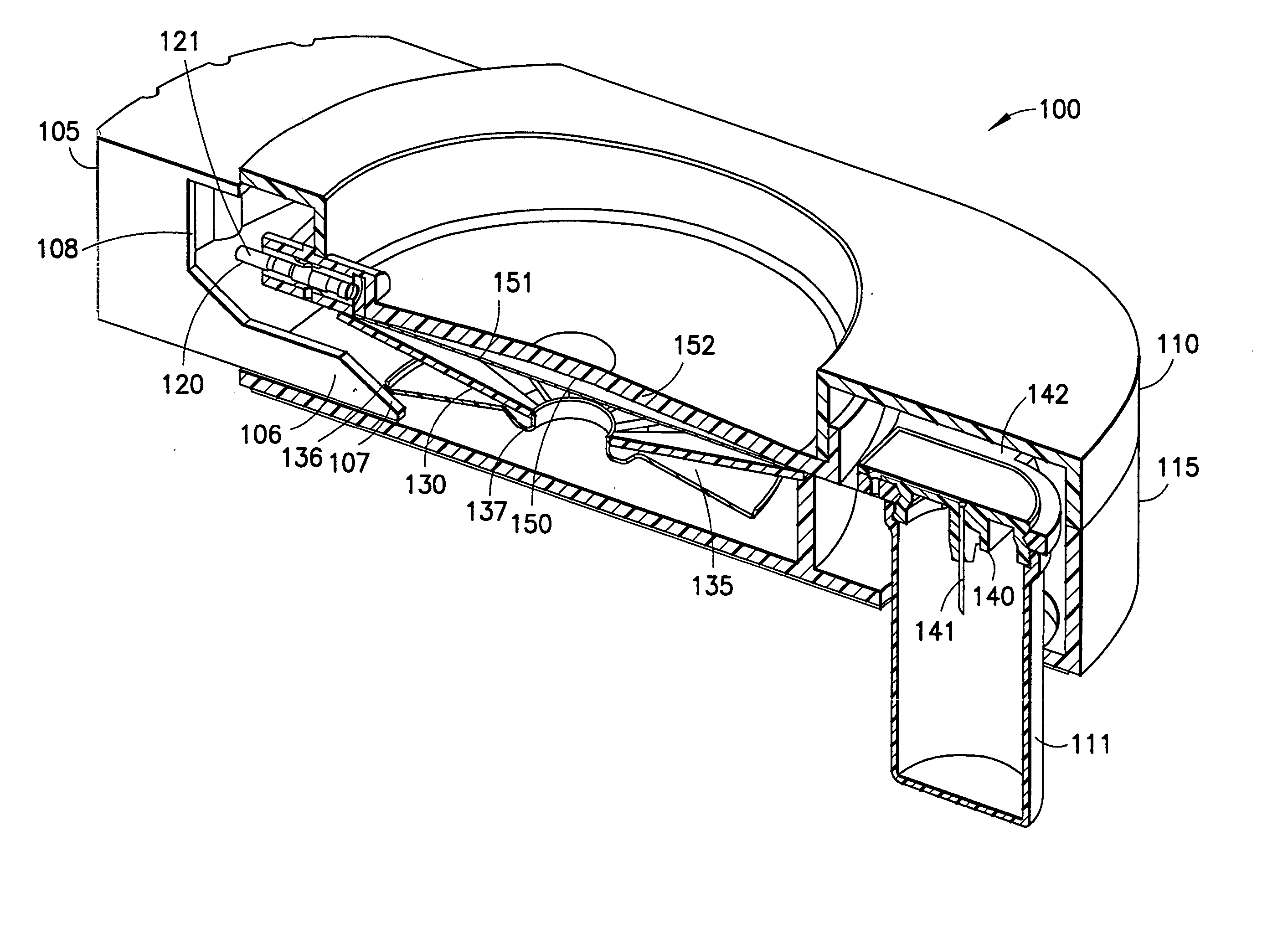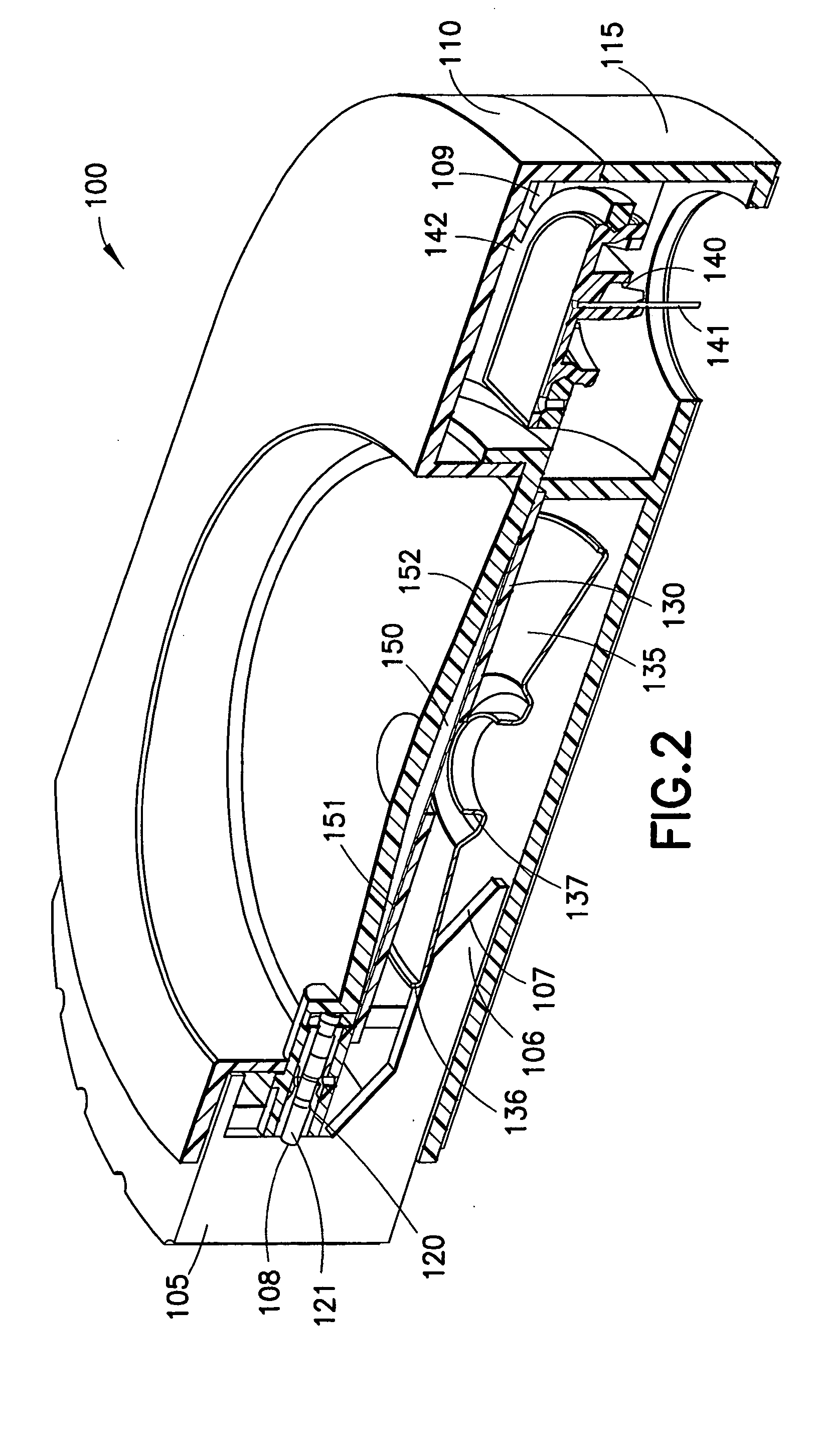Patch-like infusion device
- Summary
- Abstract
- Description
- Claims
- Application Information
AI Technical Summary
Benefits of technology
Problems solved by technology
Method used
Image
Examples
first embodiment
[0180] a push valve assembly 222 is shown in FIGS. 5 and 6. FIG. 5 is cross-sectional view of a valve assembly 122 in a closed position and FIG. 6B is cross-sectional view of the valve assembly of FIG. 5 in an open position. The valve assembly 222 includes a plastic button 223 slidably engaged within a rubber stopper 224 in fluid communication with the reservoir 150. The valve assembly 222 has as an initial state and an activated state, and includes a large diameter distal end having a distal set of radially projecting fins, or ribs 225, and a reduced diameter proximal end having a proximal set of detents 226. In the initial state, the valve 222 distal ribs 225 serve to prevent microbial ingress into the fluid path 227, and the proximal detents create a seal to trap the drug safely within the reservoir 150. Both sets of ribs 225 and detents 226 are performing critical tasks in preventing fluid loss from inside the reservoir over long periods of time as well as preventing contaminati...
second embodiment
[0183] a valve assembly 242 is shown in FIG. 7. FIG. 7 is cross-sectional view of a second valve assembly embodiment in an open position. The valve assembly 242 includes a plastic button 247, and is configured to operate as a pull valve. As shown in FIG. 7, when pushed forward, the plastic button 247 mateably engages a reservoir 150 opening and prevents fluid communication from the reservoir 150. When pulled from the reservoir 150 opening, the gap produced allows fluid communication along the conical face of the button 247 and to the fluid path 154 toward the patient needle manifold (not shown).
[0184] The valve assembly 242 has as an initial state and an activated state, and includes a large diameter distal end having a distal set of detents 243, a conical section 244 and a reduced diameter proximal end 245. In the initial state, the valve 242 distal detents 243 serve to prevent microbial ingress into the fluid path 246, and the conical section 244 and proximal end 245 create a seal...
third embodiment
[0186] a valve assembly 262 is shown in FIG. 8. FIG. 8 is cross-sectional view of a fourth valve assembly embodiment in an open position, and includes a plastic member 263, configured to operate as either a push or pull valve. As shown in FIG. 8, when pulled outward, the plastic member 263 obstructs a reservoir opening and prevents fluid communication from the reservoir 150. When pushed forward the plastic member aligns an opening and allows fluid communication between the reservoir 150 and the patient needle manifold 140 (not shown).
[0187] The valve assembly 262 has as an initial state and an activated state, and includes a distal end having a distal set of detents 264, and an enlarged diameter proximal end 265. In the initial state, the valve 262 distal detents 264 serve to prevent microbial ingress into the fluid path 267, and the enlarged proximal end 265 creates a seal with the end 266 of a plug insert member 270 to trap the drug safely within the reservoir 150. Each of the det...
PUM
 Login to View More
Login to View More Abstract
Description
Claims
Application Information
 Login to View More
Login to View More - R&D
- Intellectual Property
- Life Sciences
- Materials
- Tech Scout
- Unparalleled Data Quality
- Higher Quality Content
- 60% Fewer Hallucinations
Browse by: Latest US Patents, China's latest patents, Technical Efficacy Thesaurus, Application Domain, Technology Topic, Popular Technical Reports.
© 2025 PatSnap. All rights reserved.Legal|Privacy policy|Modern Slavery Act Transparency Statement|Sitemap|About US| Contact US: help@patsnap.com



